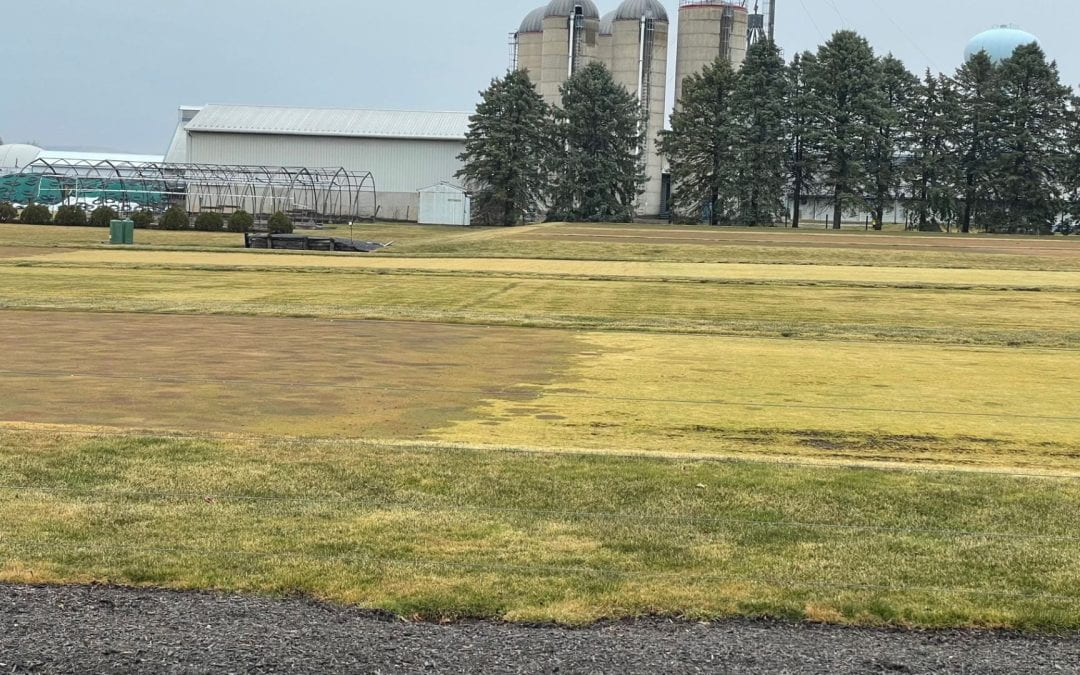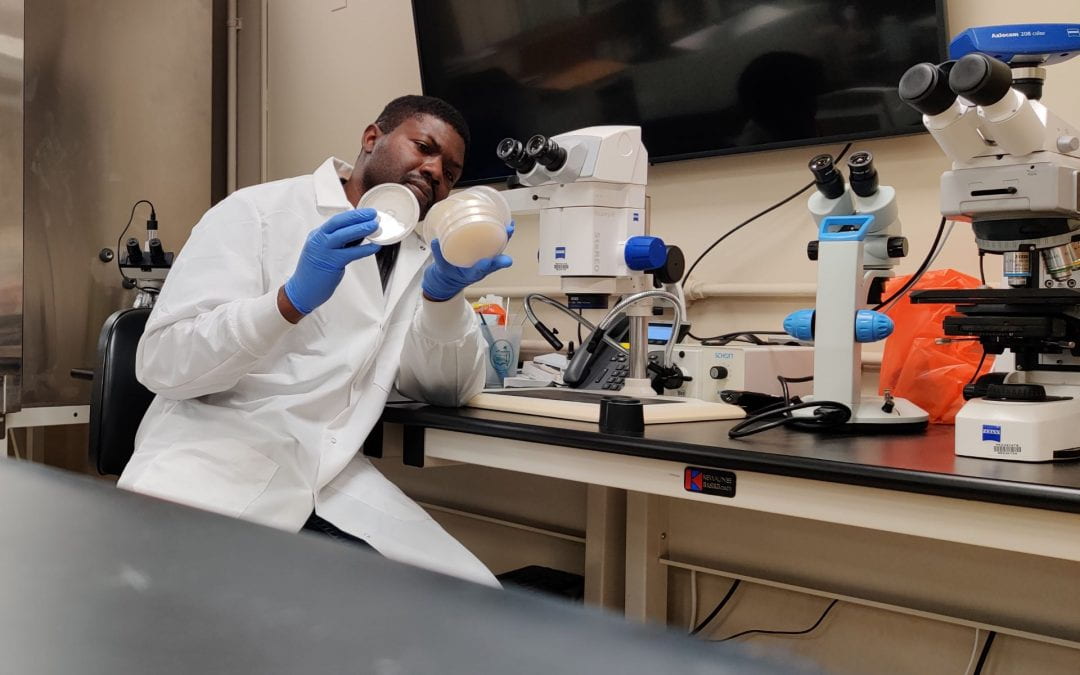
by John Kaminski | Mar 21, 2023 | General Updates, Weeds

Spring Awakening: Golf Course Season Kicks Off with Turf Pest Diagnostic Focus
As the sun peeks out from the cloudy winter skies and the temperature rises, golf enthusiasts eagerly anticipate the start of the golf course season. While the players are honing their swings and preparing their equipment, turf managers are also gearing up for a busy season ahead. A key aspect of managing golf course greens is turf pest diagnostics, with the primary focus on keeping the grass healthy and pristine. In State College, PA, we are hitting the perfect timing for controlling annual bluegrass seedheads.
Turfgrass Waking Up
The transition from winter to spring marks a significant change in the life cycle of turfgrass. As temperatures rise and daylight hours increase, the grass begins to break dormancy and enters a period of active growth. This is a critical time for turf managers, as they must carefully monitor the health and vigor of the turf and address any issues that may arise. For those managing bentgrass greens, this is the time when anthocyanin build up in patches can sometime mimic disease activity. These patches will disappear as the turf starts to grow.
Annual Bluegrass Seedhead Control
Annual bluegrass, also known as Poa annua, is a common turfgrass species found on many golf courses. Although it can provide a playable surface, it is not the most desirable grass for golf courses due to its propensity to produce seedheads, which can affect ball roll and overall playability.
As we enter the prime seedhead production period in State College, PA, it’s essential for turf managers to focus on implementing effective control measures. This is usually done by applying plant growth regulators (PGRs) that suppress seedhead formation and reduce the overall Poa annua seed bank on the greens.
Timing Is Everything
Applying PGRs at the optimal time is crucial for effective seedhead control. The ideal window for application is when the turfgrass is just beginning to break dormancy and before the seedheads start to emerge. To determine the best time to apply PGRs, turf managers can monitor growing degree days (GDDs), which is a measurement of accumulated heat units. The target GDD range for effective PGR application is typically between 200-500 GDDs, depending on the product being used. At Penn State we hit 200 GDDs this week and seedhead treatments have gone out.
Best Practices for PGR Application
- Choose the right PGR: Select a product specifically designed for annual bluegrass seedhead control, such as mefluidide (if you still have any) or combinations of ethephon + trinexapac-ethyl or prohexadione calcium.
- Follow label instructions: Read and adhere to the recommended application rates and guidelines provided by the manufacturer.
- Monitor weather conditions: PGRs are most effective when applied under mild temperatures and adequate soil moisture. Avoid applying during extreme weather conditions, such as heavy rain or drought.
- Keep an eye on GDDs: Monitor GDDs to help determine the most effective window for PGR application.
- Record your results: Keep a log of your PGR applications, including the date, product, rate, and weather conditions. This will help you refine your approach in future seasons.
Conclusion
The start of the golf course season is an exciting time for both players and turf managers. As the turfgrass wakes up and begins to grow, it’s crucial to stay vigilant and address any potential pest issues promptly. Also note that turfgrass in our area isn’t going to really move until some warmer temps make their way here. Despite The Masters being on TV soon, remind your members that we don’t live in Georgia!

by John Kaminski | Dec 6, 2021 | General Updates
The Department of Plant Science is pleased to announce the launch of the Turf Pest Diagnostic Lab that will provide rapid diagnosis and recommendations for commercial turfgrass managers in Pennsylvania and around the world.
Diagnosing turfgrass pest problems quickly is essential when managing high-value turfgrass areas such as golf courses, sports fields, and sod farms. Due to the unique nature and difficulty of pest identification, professional turfgrass managers often rely on services offered by commercial diagnostic labs. These labs benefit from the trained expertise of diagnosticians dedicated to identifying the causal agent(s) and offering cultural and chemical recommendations to help minimize damage and maintain healthy turf.
The core principle of the lab is to provide rapid disease, insect, and/or weed identification for the commercial turfgrass industry and assure the success of the site’s manager. The lab will be managed by Dr. Louis Bengyella, associate research professor and lead diagnostician. According to Bengyella, “Accuracy and speed are what the diagnostic lab offers its clientele. We are also in constant communication with each client from sample arrival to identification of the pest and offer management options when requested.”
The lab will rely on the expertise of turfgrass faculty in the Department of Plant Science including John Kaminski, Professor of turfgrass management, and Ben McGraw, Associate Professor of turfgrass entomology. “Our goal is to take the guessing game out of the hands of turfgrass managers and use our combined expertise to provide accurate results and recommendations as quickly as possible,” said Kaminski. In most cases, diagnosis is made within 24 hours of receiving a sample in the lab, and often sooner. Clients are initially notified of the diagnosis by text, email, or phone and are then sent a formal diagnostic report for their records.
The diagnostic lab was conceived out of the need to close the gap for a fast and reliable service for the turfgrass community in Pennsylvania and surrounding areas. According to Kaminski, who has over 24 years of diagnostic experience, “In addition to helping out the industry, we benefit from being up-to-date on active pests and can utilize that information to warn others of what might be heading their way.” One way that the group plans to do this is through a series of social media platforms, blogs on their website, and the mobile diagnostic app Turfpath.
The lab’s new website, turfpestlab.psu.edu, will feature an active blog that will share current pest updates, timely pest management recommendations, and even provide some insights into the procedures used to diagnose problems. In addition to the website, the lab will use the free mobile app Turfpath developed by Kaminski to send regional-specific SMS updates to notify turfgrass managers of what pests are active in their area. Information will also be shared across their social media platforms under the username @PSUTurfPests.
In addition to identifying and solving unknown problems for turfgrass managers, another key component of the lab will be to monitor and track pesticide resistance that can limit or reduce the ability of a product to control resistant insects, weeds, and pathogens. By identifying resistant pest populations at individual properties, the team can then work with managers to develop more effective pesticide programs for their facility. “Utilizing our research on pesticide resistance, in combination with the lab’s pesticide resistance screening service, allows us to make recommendations that will reduce pesticide use while still maintaining high turfgrass quality,” said Kaminski.
Now open to all commercial turfgrass managers, the lab did a soft launch in 2021 and worked with a select number of properties in the region. “The Penn State Diagnostic Lab has been a tremendous resource for us at Butler Country Club,“ said Micah Lowell, Golf Course Superintendent at Butler Country Club. “If we are not 100% sure of what we are looking at in the field, we will send samples out to the lab for confirmation because we cannot waste time and money spraying incorrect pesticides. We trust the fantastic services they provide.”
Services currently offered by the Turf Pest Diagnostic Lab include:
- Disease, insect, and weed identification
- Pesticide resistance screening
- Endophyte screening and identification
- Molecular pathogen detection
- DNA sequencing to the species level
In addition to providing support for turfgrass managers in Pennsylvania and the surrounding regions, the lab has received international permits to accept samples from around the world. As the lab expands it plans to add nematode assays and other helpful services to benefit the industry. “Establishing this lab has been a goal of mine for a long time and will build upon the assistance that the Penn State turf team provides for the entire industry,” said Kaminski.
For more information on the lab’s services and sampling/shipping instructions, please visit www.turfpestlab.psu.edu.



